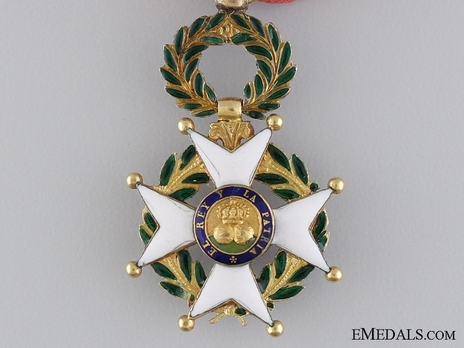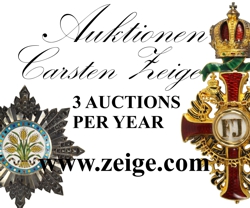Royal and Military Order of Saint Ferdinand, II Class Gold Cross (reduced size)
CATEGORY: Version
SKU: 01.ESP.0110.208.01.001
Estimated market value:





Estimated market value:
The Royal and Military Order of Saint Ferdinand (Real y Militar Orden de San Fernando) was originally founded by the General Courts of Cadiz as a National Order on August 31, 1811. It was approved by King Fernando VII/Ferdinand VII on November 28, 1814, right after the restoration of his throne; and it was switched as a Royal and Military Order in 1815.
The Order was established in recognition of all military personnel who participated at the Peninsular War, an engagement against Napoleonic army that took place in Spain between 1807-1814. On this occasion, the Order was mainly conferred upon European royal armies from Spain, Great Britain, Portugal, and France, among others.
Throughout 19th century, the Order was awarded in recognition of distinguished services and eminent acts of heroism in the defense of Spain and its citizens. Frequently, it was awarded to foreigners military personnel, even though the statutes declared that the Order should only be granted to Spanish soldiers.
The Order may be conceded in two classes; the decorations with laurel wreath (Laureate) were granted in recognition of heroism and acts of courage, while the decoration without laurel wreath were conceded for distinguished services. In some rare occasion the decoration depicted fleur-de-lys instead of the laurel wreath, in recognition of meritorious and outstanding military services.
In 1856, the insignia for lowest ranks was changed to a Latin cross consisting of four central swords united by the hilts. This is the current design of the Order's breast star.
In 1920, the Order without surrounded laurel wreath was abolish for all the ranks, instead the Military Medal was created to recognize distinguished service rendered to Spain. Since then, the Order has consisted of the badge superposed upon a green laurel wreath, known as Laureate Cross, rewarding in recognition of heroism and courage.
In 1931, the Order was modified by the Second Spanish Republic, however these changes were abolished by Francisco Franco in 1937, and the Order was re-instituted in 1949.
Currently, the Order is awarded to Spanish military personnel, individuals or collectives, in recognition of meritorious acts of heroism and courage displaying in the defense of Spain. It is the first military order establishing in Spain, and it is the highest military award in the country.
The Order is classified into three types based on the grade's changes. Type I includes the original grades of 1811 to 1815; Type II contains the grades between 1815-1920; and Type III consists of the awards after 1920.
In Type II (1815-1920), the Order's grades were Grand Cross (or V Class), IV Class, III Class, II Class, and I Class. The Grand Cross was conferred upon Chiefs, IV and III Classes were conferred upon Generals, while II and I Classes were conferred upon Officers and enlisted men.
The Order was awarded to the French Army of Angulema in 1823, also known as the Hundred Thousand Sons of Saint Louis, which served to Ferdinand VII and helped him to return to Spain after Napoleonic invasion. These awards featured a special design displaying the laurel wreath leaves pointing down. It was awarded to the 1000 men.
During 1833 and 1880, the Order was awarded mainly to Spanish and foreign soldiers who taking part in the Carlist Wars. The Order was awarded by both sides of the conflict, Carlists and Liberalism. When the war ended in 1880, both awards were ratified by the Order.
The Order features an obverse inscription that translates to “To Military Merit,” and a reverse inscription that translates to "King and Fatherland."
II Class consisted of a gold laureate badge to Officers, and a silver laureate badge to enlisted men.

Comments
Sign in to comment and reply.


Scroll Top